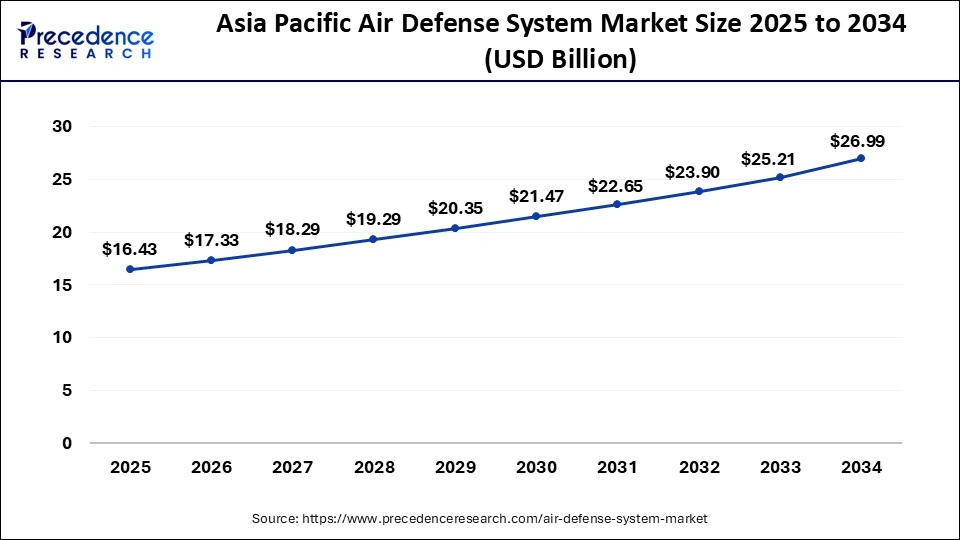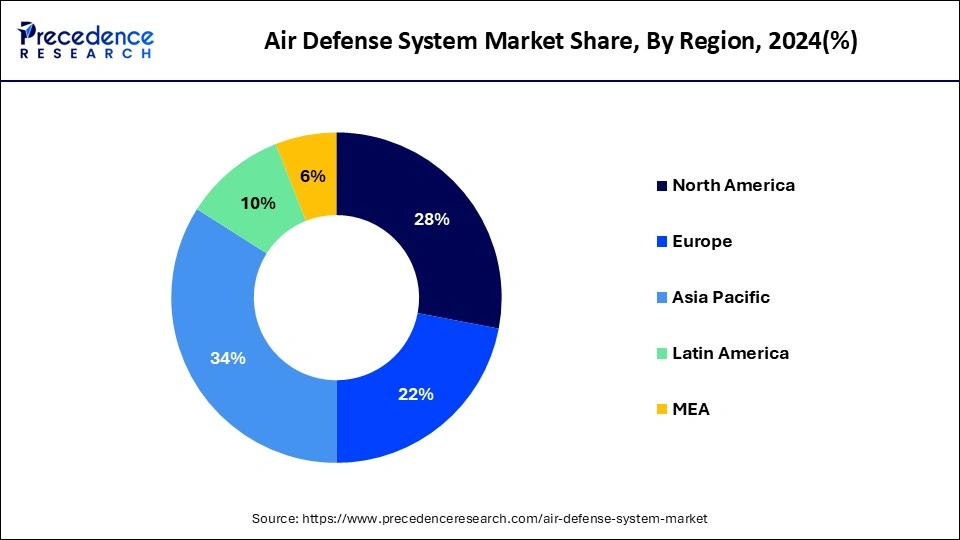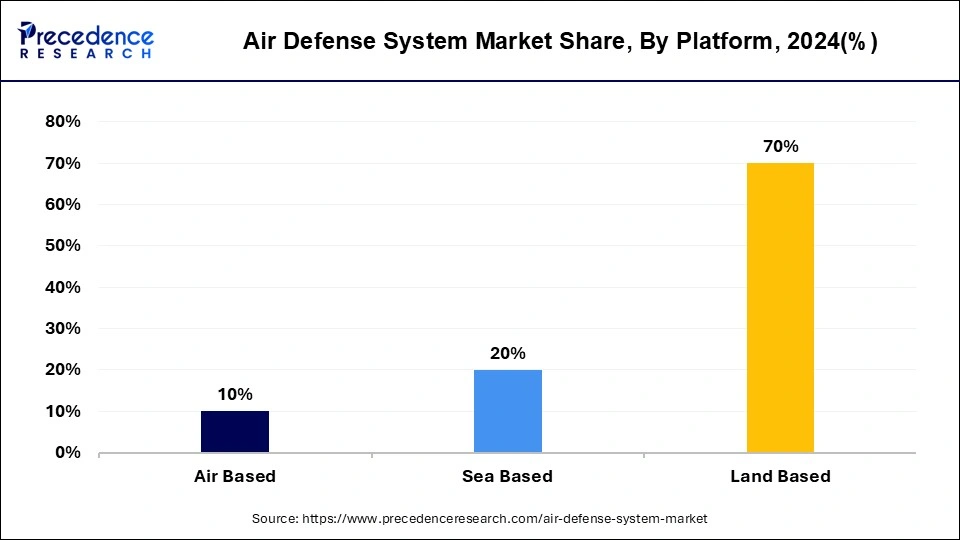List of Contents
Air Defense System Market Size and Forecast 2025 to 2034
The globalwas estimated at USD 45.80 billion in 2024 and is predicted to increase from USD 48.32 billion in 2025 to approximately USD 78.23 billion by 2034, expanding at a CAGR of 5.5% from 2025 to 2034.

Air Defense System Market Key Takeaways
- In terms of revenue, the market is valued at $48.32 billion in 2025.
- It is projected to reach $78.23 billion by 2034.
- The market is expected to grow at a CAGR of 5.5% from 2025 to 2034.
- Asia Pacific led the global market with the highest market share of 34% in 2024.
- Europe region is estimated to expand the fastest CAGR between 2025 and 2034.
- By Platform, the land based segment has held the largest market share of 69% in 2024.
- By Range, the medium range air defense (MRAD) system segment captured the biggest revenue share in 2024.
- By Type, the missile defense system segment is estimated to hold the highest market share in 2024.
- By Component, the Weapon system segment registered the maximum market share in 2024.
Asia Pacific Air Defense System Market Size and Growth 2025 to 2034
The Asia Pacific air defense system market size was estimated at USD 15.57 billion in 2024 and is predicted to be worth around USD 26.99 billion by 2034, at a CAGR of 5.65% from 2025 to 2034.

Asia Pacific is the largest and the fastest-growing market in the global air defense system market in 2024. The rising defense budgets of countries like China, India, South Korea, Pakistan, Indonesia, and Vietnam are the major drivers of the Asia Pacific air defense system market. The rising territorial disputes in the south Asia and South China Sea regions has significantly fostered the demand for the air defense system market across the region. The most prominent defense exporters like Russia, US, and Israel are witnessing a huge growth potential in the Asia Pacific region. The advanced technologies adopted by the major air defense system manufacturers are attracting the various emerging nations in Asia Pacific region to purchase those systems. China has border disputes with almost all of its neighbors, which is significantly driving the demand for the air defense systems among the neighbors of China. The rising investments in the development of advanced and untraceable missiles are boosting the expenditure towards the adoption of air defense systems.

Europe is also expected to be the fastest-growing market during the forecast period. The ongoing war between Russia and Ukraine has resulted in a rapid spike in the demand for the air defense systems among the neighbor peers of Russia like Sweden, Finland, and Poland. The Nordic states in Europe considers Russia as a potential threat are deploying advanced air defense systems to protect their territories from Russian invasion.
Shield of the West: North America's Air Defense Supremacy
- United States: The global frontrunner due to its expansive military programs, R&D capabilities, and massive defense budget. Developing its border and aerial defense gradually with foreign partnerships.
- Canada: Active in NORAD collaboration with the U.S. and invests in Arctic surveillance. Maintains modest legacy systems; shows interest in upgrading.
Strengthening Defense Through Unity
- Expansion of cross-border defense collaborations (e.g., EU Sky Shield Initiative).
- Investment in interceptor missiles, drones, and command centres.
- Prioritisation of next-gen radar and anti-drone systems.
Market Overview
Increased defense budgets: Many countries have raised defense allocations with a focus on air security amid evolving geopolitical tensions.Joint military programs: Collaborative projects like NATO's integrated air and missile defense and U.S.-Japan missile co-development are key drivers.
Domestic manufacturing push: Governments are encouraging indigenous development of defense systems through public-private partnerships, reducing dependency on imports.
Technological advancements in the market
- Directed energy weapons (DEW): Lasers and microwave weapons are being tested and deployed as futuristic tools to disable aerial threats silently and efficiently.
- Hypersonic interceptors: Research into defending against hypersonic missiles is gaining momentum, with faster interceptors under development.
- AI-enabled radar systems: Intelligent radar systems that adapt to changing environments and can distinguish between decoys and real targets are now being integrated.
Air Defense System Market Growth Factors
The rising defense expenditure in various developed and emerging countries for developing various missile and air defense systems, rising geopolitical instabilities, and changing nature of warfare are the prominent factors that are expected to boost the growth of the global air defense system market during the forecast period. The nature of the air warfare has changed with the introduction of more untraceable, agile, and lethal weapons that are autonomous in nature. Every country is trying to safeguard their territories against the potential adversaries. The increased importance of missiles and aircrafts in the modern-day warfare has significantly attracted huge investments towards the development and deployment of advanced air defense systems along the borders of countries. The huge government expenditures in the research and development of new and advanced air defense systems has led to the growth of the global air defense system market. The rapid spike in the military budgets owing to the geopolitical tensions has led to the growth of the air defense system market across the globe.
The various market players and their huge investments in the development of advanced air defense systems is expected to foster the market growth. For instance, in October 2022, Lockheed Martin invested in the development and manufacturing of hypersonic systems to be used against the emerging threats from the neighboring peer adversaries. The introduction of latest software and digital technologies is expected to enhance the performances of the air defense systems and ensure the safety of the aerial territories. The various manufacturers are increasingly adopting the various technologies such as high power lasers, mobile air defense integrated systems, multi-location radars, and missile warning systems that is expected to boost the demand for the latest air defense systems across the globe.
Key Market Trends
- Integration of multi-layered defense: Countries are now adopting tiered air defense strategies combining short, medium, and long-range systems for a holistic shield against aerial threats, including drones, aircraft, and ballistic missiles.
- Rise of counter-UAS systems: The growing threat of unmanned aerial vehicles (UAVS) has led to the rapid development of counter-drone technologies, including electromagnetic pulse weapons and jamming tools.
- Shift towards mobile air defense units: Nations are focusing on mobility and agility in air defense, with truck-mounted launch systems and radar units that can rapidly deploy and reposition.
- AI and sensor fusion: Artificial Intelligence is now being used to fuse radar, infrared, and satellite data, enhancing target recognition, tracking precision, and real-time decision-making.
Market Scope
| Report Coverage | Details |
| Market Size by 2034 | USD78.23 Billion |
| Market Size in 2025 | USD 48.32 Billion |
| Market Size in 2024 | USD 45.80Billion |
| Market Growth Rate from 2025 to 2034 | CAGR of 5.5% |
| Largest Market | Asia Pacific |
| Fastest Growing Region | Europe |
| Base Year | 2024 |
| Forecast Period | 2025 to 2034 |
| Segments Covered | Platform, Range, Type, Component and Region |
| Regions Covered | North America, Europe, Asia-Pacific, Latin America, and Middle East & Africa |
Platform Insights
The land segment dominated the global air defense system market in 2024. It accounted for a market share of around 70% in 2024. The demand for the land based air defense systems is higher owing to the rising need for protecting ground stations and personnel from any incoming aerial threats. Various developed nations are engaged in manufacturing technologically advanced air defense systems. For instance Russia's S-400 anti-craft weapon system is known to be among the most advanced air defense systems that are currently in operation. The nations like India and Turkey are the recent buyers of the S-400 systems. US is also procuring land based midcourse defense systems. Therefore, the rising demand for the land based air defense systems across the major markets has led to the growth of this segment.

The sea segment accounted for the second largest market share in 2024. This is attributed to the increased demand for the sea based air defense systems to protect the naval ships from any missile or other aerial adversaries. The navy of any country plays a crucial role in attacking as well as defending from the enemy. Hence, to protect that huge naval ships and naval bases, the demand for the sea based air defense systems is high across the major nations with naval forces.
Range Insights
The medium range air defense (MRAD) system segment dominated the global air defense system market in 2024. The growing number of conflicts among countries such as China-Taiwan, China-India, China-Japan, Russia-Ukraine, and Israel-Middle East nations are the significant factor that are driving the demand for the MRAD systems. The rising conflicts to gain territorial ownership among the neighboring nations have boosted the adoption of the MRAD systems in almost all the major regions across the globe.
The growing importance to locate the aerial threats is stimulating the demand for the long range air defense (LRAD) system across the globe. The growing need to protect the territories, the major nations is deploying LRAD systems to counter and dismantle any incoming adversaries before it reaches the target. This factor is stimulating the growth of this segment significantly. Moreover, the LRAD systems are used as a tool to show-off the technological advancement and power to the other nations as a part of the defense strategy.
Type Insights
Based on type, the missile defense system led the global market in terms of revenue in the year 2024 and expected to retain its dominant position during the forthcoming years. The prime factors attributed to the escalating growth of the segment include high demand for missile defense across military applications along with increased usage of missile during any war. In addition to this, increased investment from the government of Iran, Russia, China, the U.S., North Korea, India, and France are likely to prosper the market growth for air defense
On the other hand, anti-aircraft system predicted to register prominent growth over the forecast period owing to increasing emphasis of the governments of various nations towards strengthening their aircraft defense system. As of 2020, Russia, the U.S., France, and Israel have the best anti-aircraft system of the world. For instance, S-400 defense system of Russia is the third-generation surface to air anti-aircraft system that is used for fight with dense and multi target air strikes in various altitude ranging from ultra-low to high. The Russian Land Defense Forces are currently having the best class anti-aircraft systems and are also investing significantly in order to upgrade the quality of their defense systems. These initiatives taken by the government of various nations are likely to propel the anti-aircraft defense system during the upcoming years.
Component Insights
Weapon system held significant market revenue in the year 2024 in the global air defense system market. Prime factor supporting the prominent growth of the segment includes increasing emphasis of today's warfare on missile improvement and modernization. Presently, almost every country is investing towards upgrading the quality of their missiles in order to make their defense system stronger and more compatible with other nations. For instance, in April 2022, the government of U.S. has proposed to invest around US$ 900 million in order to procure a new missile defense system from Guam. The initiative taken by the government of the U.S. was to address the rising threat of missiles from China. Similarly, other nations are also investing prominently in upgrading their missile technology along with their launching pads in respect to strengthen their defense system and technologies.
Air Defense System Market Companies
- Hanwha Corporation
- Northrop Grumman Corporation
- Raytheon Company
- Saab AB
- Lockheed Martin Corporation
- Bae Systems PLC
- Thales Group
- Rheinmetall AG
- MBDA
- Kongsberg Gruppen
- Aselsan A.S.
- General Dynamics
- L3 Harris
- Elibit Systems
- JSC Concern Vko "Almaz-Antey"
- The Boeing Company
- Israel Aerospace Industries Ltd.
- Leonardo S.P.A.
Recent Developments
- In May 2025, Military and industrial leaders in Kyiv announced their intentions to work with international partners to produce air-defense systems domestically in Ukraine, the same sorts of missile systems for which the country now relies on stockpiles in the U.S. and Europe, Volodymyr Zelensky said on Wednesday.
- In November 2021, India received its first batch of S-400 Air Defense system from Russia. The dealwas worth US$5.4 billion for five S-400 systems. This deal was signed between Russia and India during the Russian President Putin's visit to India in 2018. Putin is scheduled to visit India in December 2021 to renew military co-operation agreement forReciprocal Exchange of Logistics Agreement.
- In November 2018, Saudi Arabia entered into an agreement with the U.S. to buy 44 THAAD missiles and launchers for US$15 billion.
- In October 2021, Lockheed Martin invested in the development and manufacturing of hypersonic systems to be used against the emerging threats from the neighboring peer adversaries.
The various developmental strategies adopted by the government of various nations and various market players such as agreements, partnerships, new product launches, and joint ventures are expected to significantly influence the growth of the global air defense system market in a positive way. The market players are constantly engaged in research and developmental activities to gain a competitive edge and gain market share.
Segments Covered in the Report
By Platform
- Land Based
- Sea Based
- Air Based
By Range
- Short Range Air Defense System
- Medium Range Air Defense System
- Long Range Air Defense System
By Type
- Missile Defense System
- Anti-Aircraft System
- Counter Rocket, Artillery, and Mortar (C-RAM) System
By Component
- Weapon System
- Turret Systems
- Missile Launching System
- Fire Control System
- Air Defense Radar
- Electro-Optic & Laser Range Finder
- Command and Control System
- Others
By Geography
- North America
- U.S.
- Canada
- Europe
- U.K.
- Germany
- France
- Asia-Pacific
- China
- India
- Japan
- South Korea
- Malaysia
- Philippines
- Latin America
- Brazil
- Rest of Latin America
- Middle East & Africa (MEA)
- GCC
- North Africa
- South Africa
- Rest of the Middle East & Africa
For inquiries regarding discounts, bulk purchases, or customization requests, please contact us at sales@precedenceresearch.com
Frequently Asked Questions
Ask For Sample
No cookie-cutter, only authentic analysis – take the 1st step to become a Precedence Research client